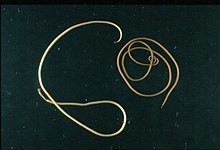Nematomorpha
| Nematomorpha Temporal range: Possible
Atdabanian Record | |
|---|---|

| |
| Paragordius tricuspidatus | |
| Scientific classification | |
| Domain: | Eukaryota |
| Kingdom: | Animalia |
| Subkingdom: | Eumetazoa |
| Clade: | ParaHoxozoa |
| Clade: | Bilateria |
| Clade: | Nephrozoa |
| (unranked): | Protostomia |
| Superphylum: | Ecdysozoa |
| Clade: | Nematoida |
| Phylum: | Nematomorpha Vejdovsky , 1886
|
| Orders and families | |
| |
Nematomorpha (sometimes called Gordiacea, and commonly known as horsehair worms, hairsnakes,
Description and biology
Nematomorphs possess an external
Reproductively, they have
The adults are mostly free-living in freshwater or marine environments, and males and females aggregate into tight balls (Gordian knots) during mating.[9][10]

In
There are a few cases of accidental parasitism in vertebrate hosts, including dogs[15] and humans. Several cases involving Parachordodes, Paragordius, or Gordius have been recorded in human hosts in Japan and China.[16][17]
Community ecology
Taxonomy
Nematomorphs can be confused with nematodes, particularly mermithid worms. Unlike nematomorphs, mermithids do not have a terminal cloaca. Male mermithids have one or two spicules just before the end apart from having a thinner, smoother cuticle, without areoles and a paler brown colour.[19]
The phylum is placed along with the Ecdysozoa clade of moulting organisms that include the Arthropoda. Their closest relatives are the nematodes. The two phyla make up the group Nematoida in the clade Cycloneuralia. During the larval stage, the animals show a resemblance to adult kinorhyncha and some species of Loricifera and Priapulida, all members of the group Scalidophora.[20] The earliest Nematomorph could be Maotianshania, from the Lower Cambrian; this organism is, however, very different from extant species;[21] fossilized worms resembling the modern forms have been reported from mid Cretaceous Burmese amber dated to 100 million years ago.[22]
Relationships within the phylum are still somewhat unclear, but two classes are recognised. The five marine species of nematomorph are contained in
The approximately 320 remaining species are distributed between two families,
References
Citations
- ^ Heston, Joshua. "Horse Hair Snake". State of the Ozarks. Retrieved 1 January 2021.
- ^ Troxell, W.H. (30 January 1903). "Erroneous Beliefs" (PDF). Emmitsburg Chronicle. No. 37. Archived (PDF) from the original on 2021-05-09. Retrieved 1 January 2021.
- ^ Ningewance, Pat (8–10 August 1996). "Naasaab Izhi-anishinaabebii'igeng conference report: a conference to find a common Anishinaabemowin writing system" (PDF). Toronto, Ontario: Literacy Ontario. p. 27. Archived (PDF) from the original on 2020-10-22.
Girls, don't swim without pants or a hairsnake will enter you.
- )
- (PDF) from the original on 2022-10-10.
- S2CID 37985613.
- Greenwood Press.
- ^ ISBN 978-0-03-056747-6.
- ^ S2CID 86278524. Archived from the original(PDF) on 2015-09-24. — according to Thomas et al., the "infected insects may first display an erratic behaviour which brings them sooner or later close to a stream and then a behavioural change that makes them enter the water", rather than seeking out water over long distances.
- PMID 21708759.
- PMID 12705936.
- S2CID 7777607.
- ^ "Parasites manipulate praying mantis's polarized-light perception, causing it to jump into water". phys.org. Retrieved 2021-07-04.
- ^ This Parasitic Worm ‘Steals’ Genes From Its Unsuspecting Host
- PMID 26797439.
- PMID 22949758.
- PMID 3430914.
- S2CID 20274754.
- ^ Malcolm S. Bryant, Robert D. Adlard & Lester R.G. Cannon 2006. Gordian Worms: Factsheet. Queensland Museum. "Archived copy" (PDF). Archived from the original (PDF) on 2008-07-22. Retrieved 2008-03-10.
{{cite web}}: CS1 maint: archived copy as title (link) - ^ Nematomorpha – Bumblebees
- ^ Sun, W.; Hou, X. (1987). "Early Cambrian worms from Chengjiang, Yunnan, China: Maotianshania gen. nov" (Paywall). Acta Palaeontologica Sinica. 26 (3): 299–305.
- PMID 16737709.
- ^ a b c Pechenik, 'Biology of the Invertebrates, 2010, pg 457.
- ^ "Gordioidea". Integrated Taxonomic Information System.
General and cited references
- Pechenik, Jan A. (2010). "Four Phyla of Likely Nematode Relatives". Biology of the Invertebrates (6th International ed.). Singapore: Mc-Graw Hill Education (Asia). pp. 452–457. ISBN 978-0-07-127041-0.
Further reading
- Baker GL, Capinera JL (1997). "Nematodes and nematomorphs as control agents of grasshoppers and locusts". Memoirs of the Entomological Society of Canada. 171: 157–211. .
- Hanelt B, Thomas F, Schmidt-Rhaesa A (2005). "Biology of the phylum Nematomorpha". Advances in Parasitology Volume 59. Vol. 59. pp. 244–305. )
- Poinar GO Jr (1991). "Nematoda and Nematomorpha". In Thorp JH, Covich AP (eds.). Ecology and Classification of North American Freshwater Invertebrates. San Diego, CA: Academic Press. pp. 249–283.
- Thorne G (1940). "The hairworm, Gordius robustus Leidy, as a parasite of the Mormon cricket, Anabrus simplex Haldeman". Journal of the Washington Academy of Sciences. 30: 219–231.
External links
- Capinera, J. L. Horsehair Worms, Hairworms, Gordian Worms, Nematomorphs, Gordius spp. (Nematomorpha: Gordioidea). University of Florida IFAS. Published 1999, revised 2005.
- Nematomorph worm – Behavior modification of cricket by nematomorph worm. YouTube.
- Gordian worms discussed on RNZ Critter of the Week, 6 November 2015
